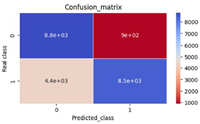Numerical investigation of heat and mass transfer of variable viscosity Casson nanofluid flow through a microchannel filled with a porous medium
Abstract
Thermal behaviours and hydrodynamics of non-Newtonian nanofluids flow through permeable microchannels have large scale utilizations in industries, engineering, and biomedicine. Therefore, this paper presents the numerical investigation of heat and mass transfer of variable-viscosity Casson nanofluid flow through a porous medium microchannel with the Cattaneo-Christov heat flux theory. The highly nonlinear PDEs corresponding to the continuity, momentum, energy, and concentration equations are formulated and solved numerically via the second-order implicit finite difference scheme known as the Keller-Box method. Accordingly, the numerical simulations reveal that the variable viscosity parameter, thermal Grashof number, solutal Grashof number, thermophoresis parameter, Schmidt number, and Casson fluid parameter show increasing effects on both velocity and temperature of the nanofluid. Furthermore, the temperature profile escalates with increasing values of the Eckert number and the thermal relaxation time parameter. Thus, the Cattaneo-Christov heat flux model is beneficial in warming the transport system of microfluidics when compared to that of the classical Fourier heat conduction law. The temperature profile, however, indicates a retarding behavior with increasing values of the Brownian motion parameter, Prandtl number, and porous medium parameters, namely the Forchheimer number and porous medium shape parameter, and hence, the porous medium quite effectively controls the nanofluid temperature distribution, which plays substantial roles in cooling the transport system of microfluidics. Moreover, the concentration profile shows an increasing pattern with escalating values of the Prandtl number, Schmidt number, and thermophoresis parameter, but it demonstrates a decreasing trend with the Casson fluid, variable viscosity, thermal relaxation time, and solutal relaxation time parameters. It is also observed that the coefficient of skin friction increases with increasing values of the pressure gradient parameter, Eckert number, Forchheimer number, and injection/suction Reynolds number. Besides, the heat transfer rate at both walls of the microchannel increases with rising values of the Eckert number, variable viscosity, parameter, and injection/suction Reynolds number. The Casson fluid and thermal relaxation time parameters reveal opposite scenarios for the heat transfer rate at the left and right walls of the microchannel. In addition
the mass transfer rate at both walls of the microchannel shows an increasing pattern as the Eckert number, variable viscosity parameter, Schmidt number, and suction/injection Reynolds number increase.
References
[1]Bergman TL, Lavine AS, Incropera FP, DeWitt DP. Fundamentals of Heat and Mass Transfer. Wiley & Sons; 2011.
[2]Holman JP. Heat Transfer, 10th ed. McGraw-Hill Education; 2010.
[3]Tuckerman DB, Pease RFW. High-performance heat sinking for VLSI. IEEE Electron Device Letters 1981; 2(5): 126–129. doi: 10.1109/EDL.1981.25367
[4]Saleel CA, Algahtani A, Badruddin IA, et al. Pressure-driven electro-osmotic flow and mass transport in constricted mixing micro-channels. Journal of Applied Fluid Mechanics 2019; 13(2): 429–441. doi: 10.29252/jafm.13.02.30146
[5]Reddy KV, Makinde OD, Reddy MD. Thermal analysis of MHD electro-osmotic peristaltic pumping of Casson fluid through a rotating asymmetric microchannel. Indian Journal of Physics 2018; 92(11): 1439–1448. doi: 10.1007/s12648-018-1209-1
[6]Kmiotek M, Kucab-Pietal A. Influence of slim obstacle geometry on the flow and heat transfer in microchannels. Bulletin of the Polish Academy of Sciences. Technical Sciences 2018; 66(2): 111–118. doi: 10.24425/119064
[7]Dewan A, Srivastava P. A review of heat transfer enhancement through flow disruption in a microchannel. Journal of Thermal Science 2015; 24(3): 203–214. doi: 10.1007/s11630-015-0775-1
[8]Kumar R, Islam M, Hasan MM. A review of experimental investigations on heat transfer characteristics of single phase liquid flow in microchannels. International Journal of Advanced Mechanical Engineering 2014; 4(1): 115–120.
[9]Choi SUS, Eastman JA. Enhancing thermal conductivity of fluids with nanoparticles. ASME International Mechanical Engineering Congress & Exposition 1995; 66: 99–105.
[10]Subramanian KRV, Rao TN, Balakrishnan A. Nanofluids and Their Engineering Applications. CRC Press; 2020.
[11]Reddy KV, Reddy MG, Makinde OD. Thermophoresis and brownian motion effects on magnetohydrodynamics electro-osmotic jeffrey nanofluid peristaltic flow in asymmetric rotating microchannel. Journal of Nanofluids 2019; 8(2): 349–358. doi: 10.1166/jon.2019.1581
[12]Niazi MDK, Xu H. Modelling two-layer nanofluid flow in a microchannel with electro-osmotic effects by means of the Buongiorno’s model. Applied Mathematics and Mechanics 2020; 41(1): 83–104. doi: 10.1007/s10483-020-2558-7
[13]Ahadi A, Antoun S, Saghir MZ, Swift J. Computational fluid dynamic evaluation of heat transfer enhancement in microchannel solar collectors sustained by alumina nanofluid. Energy Storage 2019; 1(2): e37. doi: 10.1002/est2.37
[14]Delisle CS, Welsford CA, Saghir MZ. Forced convection study with microporous channels and nanofluid: Experimental and numerical. Journal of Thermal Analysis and Calorimetry 2019; 140(6): 1205–1214. doi: 10.1007/s10973-019-09175-8
[15]Sharaf OZ, Al-Khateeb AN, Kyritsis DC, Abu-Nada E. Numerical investigation of nanofluid particle migration and convective heat transfer in microchannels using an Eulerian-Lagrangian approach. Journal of Fluid Mechanics 2019; 878: 62–97. doi: 10.1017/jfm.2019.606
[16]Shahrestani MI, Maleki A, Shadloo MS, Tlili I. Numerical investigation of forced convective heat transfer and performance evaluation criterion of Al2O3/water nanofluid flow inside an axisymmetric microchannel. Symmetry 2020; 12(1): 120. doi: 10.3390/sym12010120
[17]Davood T, Mohammad M, Omid Ali A, et al. The effect of using water/CuO nanofluid and L-shaped porous ribs on the performance evaluation criterion of microchannels. Journal of Thermal Analysis and Calorimetry 2018; 135(4): 145–159. doi: 10.1007/s10973-018-7254-3
[18]Pouya B, Davood T, Reza BD, Masoud A. Two phase natural convection and thermal radiation of Non-Newtonian nanofluid in a porous cavity considering inclined cavity and size of inside cylinders. International Communications in Heat and Mass Transfer 2019; 108: 104285. doi: 10.1016/j.icheatmasstransfer.2019.104285
[19]Chamkha AJ, Azzi A, Menni Y. Transport of nanofluid through porous media—A review. Special Topics & Reviews in Porous Media: An International Journal 2018; 9(4): 1–16. doi: 10.1615/SpecialTopicsRevPorousMedia.2018027168
[20]Chamkha AJ, Ameur H, Menni Y. Nanofluids advances through heat exchangers. Heat Transfer 2020; 1–29. doi: 10.1002/htj.2182
[21]Algehyne EA, Wakif A, Rasool G, et al. Significance of Darcy-Forchheimer and Lorentz forces on radiative alumina-water nanofluid flows over a slippery curved geometry under multiple convective constraints: A renovated Buongiorno’s model with validated thermophysical correlations. Waves in Random and Complex Media 2022. doi: 10.1080/17455030.2022.2074570
[22]Rashad, AM, Chamkha AJ, Mansour MA, Armaghani T. MHD combined convection flow of Cu-water nanofluid through a lid-driven saturated porous enclosure with entropy generation and partial slip effects. Journal of Thermal Analysis and Calorimetry 2019; 132: 1291–1306. doi: 10.1007/s10973-018-7889-0
[23]Maneengam A, Laidoudi H, Abderrahmane A, et al. Entropy generation in 2D lid-driven porous container with the presence of obstacles of different shapes and under the influences of buoyancy and lorentz forces. Nanomaterials 2022; 12(13): 2206. doi: 10.3390/nano12132206
[24]Rasool G, Shah NA, El-Zahar ER, Wakif A. Numerical investigation of EMHD nanofluid flows over a convectively heated Riga pattern positioned horizontally in a Darcy-Forchheimer porous medium: Application of passive control strategy and generalized transfer laws. Waves in Random and Complex Media 2022. doi: 10.1080/17455030.2022.2074571
[25]Makinde OD, Lakshmi DV, Venkateswarlu M. Heat generation and thermal radiation influences on the steady hydromagnetic flow through a vertical micro-porouschannel with suction/injection. Journal of Nanofluids 2019; 8(5): 1–10. doi: 10.1166/jon.2019.1647
[26]Joshi N, Pandey AK, Upreti H, Kumar M. Mixed convection flow of magnetic hybrid nanofluid over a bidirectional porous surface with internal heat generation and a higher-order chemical reaction. Heat Transfer 2020; 50(4): 3661–3682. doi: 10.1002/htj.22046
[27]Raza J, Mebarek-Oudina F, Ali Lund L. The flow of magnetised convective Casson liquid via a porous channel with shrinking and stationary walls. Pramana 2022; 96: 229. doi: 10.1007/s12043-022-02465-1
[28]Mahmoud J, Ali Rabienataj DA, Davood T, Omidali A. Melting process in porous media around two hot cylinders: Numerical study using the lattice Boltzmann method. Physica A: Statistical Mechanics and its Applications 2018; 509: 316–335. doi: 10.1016/j.physa.2018.06.011
[29]Arasteh H, Mashayekhi R, Toghraie D, et al. Optimal arrangements of a heat sink partially filled with multilayered porous media employing hybrid nanofluid. Journal of Thermal Analysis and Calorimetry 2019; 137(3): 1045–1058. doi: 10.1007/s10973-019-08007-z
[30]Arasteh H, Mashayekhi R, Ghaneifar M, et al. Heat transfer enhancement in a counter-flow sinusoidal parallel-plate heat exchanger partially filled with porous media using metal foam in the channels’ divergent sections. Journal of Thermal Analysis and Calorimetry 2019; 141(5): 1669–1685. doi: 10.1007/s10973-019-08870-w
[31]Mehmood R, Nayak MK, Akbar NS, Makinde OD. Effects of thermal-diffusion and diffusion-thermoon oblique stagnation point flow of couple stress Casson fluid over a stretched horizontal riga plate with higher order chemical reaction. Journal of Nanofluids 2019; 8(1): 94–102. doi: 10.1166/jon.2019.1560
[32]Thammanna GT, Kumar KG, Gireesha BJ, et al. Magnetohydrodynamic analysis on stretched flow of couple stress Casson fluid with chemical reaction. Results in Physics 2017; 7: 4104–4124. doi: 10.1016/j.rinp.2017.10.016
[33]Mahanthesh B, Makinde OD, Gireesha BJ, et al. Two-phase flow of dusty Casson fluid with Cattaneo-Christov heat flux and heat source past a cone, wedge and plate. Defect and Diffusion Forum 2018; 387: 625–639. doi: 10.4028/www.scientific.net/DDF.387.625
[34]Jakeer S, Reddy PBA, Reddy SRR, Basha HT. Entropy generation and Melting heat transfer on the Ferrohydrodynamic flow of Fe_3 O_4-Ag/ blood hybrid nanofluid with Cattaneo-Christov heat flux model. Waves in Random and Complex Media 2023; 1–24. doi: 10.1080/17455030.2022.2164808
[35]Patil MB, Shobha KC, Bhattacharyya S, Said Z. Soret and Dufour effects in the flow of Casson nanofluid in a vertical channel with thermal radiation: Entropy analysis. Journal of Thermal Analysis and Calorimetry 2023; 148(3): 1–11. doi: 10.1007/s10973-023-11962-3
[36]Casson N. A flow equation for pigment-oil suspensions of the printing ink type. In: Mill CC (editor). Rheology of Disperse Systems. Pergamon Press; 1959. pp. 84–104.
[37]Cebeci T, Bradshaw P. Physical and Computational Aspects of Convective Heat Transfer. Springer New York; 1984.
[38]Roja A, Gireeesha BJ, Nagaraja B. Irreversibility investigation of Casson fluid flow in an inclined channel subject to a Darcy-Forchheimer porous medium: A numerical study. Applied Mathematics and Mechanics 2021; 42: 95–108. doi: 10.1007/s10483-021-2681-9
[39]Mahmoudi Y, Hooman K, Vafai K. Convective Heat Transfer in Porous Media. CRC Press; 2020.
[40]Rundora L, Makinde OD. Buoyance effects on unsteady reactive variable properties fluid flow in a channel filled with a porous medium. Journal of Porous Media 2018; 21(8): 721–737. doi: 10.1615/JPorMedia.2018015707
[41]Makinde OD, Khan ZH, Ahmad R, et al. Unsteady MHD flow in a porous channel with thermal radiation and heat source/sink. International Journal of Applied and Computational Mathematics 2019; 5: 59. doi: 10.1007/s40819-019-0644-9
[42]Kasaeian A, Daneshazarian R, Mahian O, et al. Nanofluid flow and heat transfer in porous media: A review of the latest developments. International Journal of Heat and Mass Transfer 2017; 107: 778–791. doi: 10.1016/j.ijheatmasstransfer.2016.11.074
[43]Menni Y, Chamkha AJ, Azzi A. Nanofluid transport in porous media: A review. Special Topics & Reviews in Porous Media: An International Journal 2019; 10(1): 49–64. doi: 10.1615/SpecialTopicsRevPorousMedia.2018027168
[44]Nayak MK, Pandey VS, Shaw S, et al. Thermo-fluidic significance of non-Newtonian fluid with hybrid nanostructures. Case Studies in Thermal Engineering 2021; 26: 101092. doi: 10.1016/j.csite.2021.101092
Copyright (c) 2023 Lemi Guta Enyadene, Ebba Hindebu Rikitu, Adugna Fita Gabissa

This work is licensed under a Creative Commons Attribution 4.0 International License.











